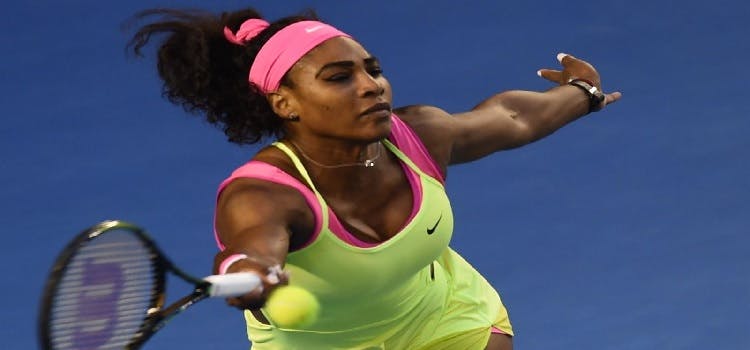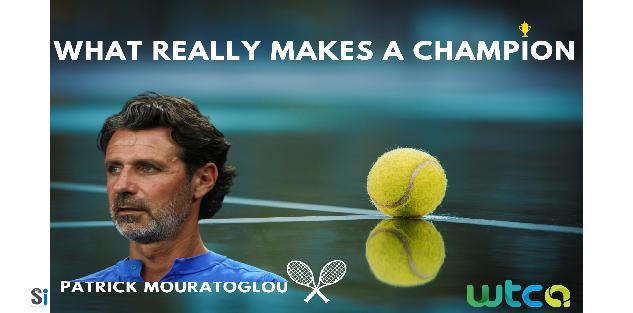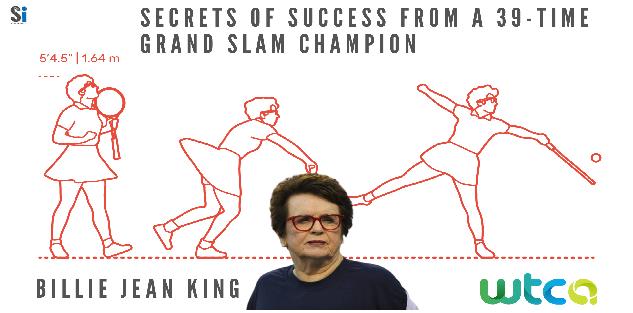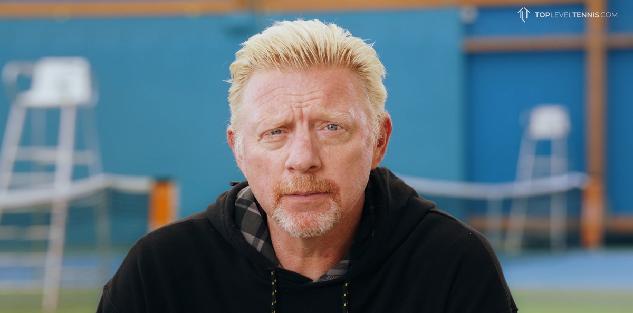Featured courses
- Four Tips to Turn Your Tennis Forehand Into a Weapon by Grant Young
- Tennis Legend Billie Jean King’s 4 Responsibilities as a Player by Grant Young
- Two Top Priorities For Success in Doubles Tennis by Grant Young
- Three of Tennis Whiz Lisa Dodson’s Tips to Improve Serves by Grant Young
- Three Elite Tennis Ball Machine Drills by Grant Young
- Three Keys For Correcting Tennis Serving Mechanics by Grant Young
- Five Tactical Tips to Win More Tennis Matches by Grant Young
- 4 Lessons Patrick Mouratoglou Learned From Coaching Serena Williams by Grant Young
- Four Effective Backhand Tennis Drills by Grant Young
- Two of Legendary Tennis Coach Paul Annacone’s Crucial Player Development Tips by Grant Young
- A Step-By-Step Guide To Mastering The Serve by Krsto Arsenijevic
- How to Dominate the Clay Court in Tennis by Krsto Arsenijevic
- 10 Essential Tennis Drills Every Coach Should Know by Brandon Ogle
- 8 Pre-Game Exercises to Prime Your Tennis Team for Competition by Neil Brown
- 7 Proven Tips To Develop Your Net Game in Tennis by Krsto Arsenijevic
- 10 Essential Tennis Drills Every Coach Should Know by Krsto Arsenijevic
- Developing Players - Two-handed backhand by Ramon Osa
- 6 Simple Warm-up Exercises For Tennis Players by Krsto Arsenijevic
- How to Beat a Serve-and-Volley Player by Krsto Arsenijevic
- How To Build Your Kinetic Chain Like Djokovic by Aiden Lefebvre
- How to neutralize a lefty in Tennis by Aiden Lefebvre
- 5 Tips To Improve Your Tennis Game Today by Krsto Arsenijevic
- Everything You Need to Know Before Buying New Tennis Shoes by Brandon Ogle
- Amp up your tennis practice with situational play by Neil Brown
- Tennis Equipment List by Brandon Ogle
- How to Master The One-handed Backhand in Tennis by Krsto Arsenijevic
- Modern High School Tennis Coaching Obstacles by Neil Brown
- Increase Your Tennis Fitness Level With 3 Easy Drills by Krsto Arsenijevic
- How to Successfully Hit a Two-Handed Backhand by Brandon Ogle
- How to Become a Grass Court Specialist in Tennis by Brandon Ogle
- How to Dominate the Hard-Court like Serena Williams by Brandon Ogle
- Hit a Drop Shot to Keep Your Opponent Off-Balance by Brandon Ogle
- New Tennis Injury Findings Linked to Neutral & Closed Stances by Oscar Wegner
- CHATTING WITH TENNIS PRO BRUCE CONNORS by Brandon
- How to Become a Mentally Strong Tennis Player by Brandon Ogle
- How to Win the Game of Angles by Hitting Cross-Court Shots by Eric Mahnke

How to Dominate the Hard-Court like Serena Williams
- By Brandon Ogle
With 20 Grand Slam singles titles, it’s safe to say that Serena Williams is one of the greatest tennis players of all-time. While she has developed her clay and hard court games over the course of her career, it is the hard court where she has proven to be particularly effective. While hard courts can vary in terms of the color, they are always made of synthetic/acrylic layers on top of concrete or asphalt.
They play differently than the other courts and require a different game plan to be successful.
Efficient First Serve
On all courts in tennis, players must be efficient and effective with their first serve. Speed and accuracy are critical to winning matches. You don’t necessarily have to serve up an ace, but possessing the ability to hit to both sides with pace can certainly be helpful. Furthermore, if you are able to consistently get your first serve in, it will reduce the number of second serves, which usually are hit at a lesser speed to avoid a double. To keep your opponent guessing, I recommend working on a flat serve, slice serve, and kick serve.
Speed and Stamina
If you’ve ever seen an intense five-setter in a major, you can see the importance of stamina. In addition, you’ll likely be playing a lot of tennis outdoors during the summer, which raises the bar ever more on the vitality of stamina. Hard courts tend to play quicker than clay, thus creating a need for speed to track down the fast shots.
Stamina also comes into play due to the fact that hard courts can take a toll on one’s body. They put a lot of stress on a player’s knees and it is for this reason that players must be well-conditioned for matches.
Stretch Plenty
The best way to ensure one’s preparation is adequate is to utilize knee bands and stretch plenty before and after playing. Due to the quick movements and changing directions, stretching becomes immensely important. However, don’t fall victim to the old mindset of stretching, but rather take advantage of the benefits of dynamic stretching.
Fast Speed Promotes Aggressive Play
On hard courts, the ball usually bounces high with speed, thus allowing a player to utilize different forms of shots. This is largely due to the fact that there isn’t much energy absorption on the court. As a result, players are going to generally hit more winners on hard than clay. While a defensive approach may work on clay, it will likely get you beat on a hard surface. Understanding your player’s weaknesses becomes increasingly important. This will allow you to change up your returns and ultimately win more points. Furthermore, don’t be afraid to attack the net. This can be an excellent tool to keep the points shorter.
Play Closer to the Baseline than in Clay
Hard courts lack the forgiving nature of clay courts. This requires a player to play their game closer to the baseline. This aggressive style allows a player to hit the ball earlier and speed up the game. In addition, a player will be in a better position to rush the net when the opportunity presents itself. The key lesson is to not stand too far back. Rafael Nadal made this adjustment after standing farther back during his dominance on clay.
All-Around Game
Becoming a successful player on hard courts usually means that you possess the ability to hit a bevy of different shots, including slices, volleys, and overheads. In order to apply an aggressive, offensive approach that looks to shorten the points, one must be able to constantly be looking for winners. Whether it be hitting a backhand slice or using a serve-and-volley approach, you must keep your opponent on the move. If you want to become a tennis player that can play on all-courts, you must be able to continuously make adjustments and improve your game. You can have the best serve in the world, like John Isner’s, but if the rest of your game is flat, you’ll consistently drop matches.
Keep the Points Short
Clay courts play under the mantra that you need to keep hitting the ball back and force your opponent to make a mistake. The fast nature of hard courts requires you to operate under a completely different mindset. You’re not going to have those long rallies on hard courts, due to the simple fact that they play better to athletes looking to hit winners. Hard court players don’t necessarily have to map out a plan of attack, but can rather go straight for the point. Even though this is the correct way to play hard courts, I also see it as being an Achilles heel for Americans playing on clay. Hard courts are easily the most common of the three surfaces in the United States, partially because of their lower cost of maintenance. However, as a result of this, I believe Americans don’t always understand the complete intellectual part of playing longer points on clay.
Appropriate Shoes
Just as seen with clay and grass courts, there are specific shoes that will allow you to play better on hard courts. Some of the key attributes you’re looking for include durability, comfort, and support. It also would be wise to think about getting a pair with solid breathability. This characteristic will be beneficial during those warm summer days that get even hotter at court level.
Dominant Hard Court Players
Over the years, many players have excelled on hard courts and especially at the two hard court majors (Australian Open and US Open). Here are few of the dominant hard-courters:
Ivan Lendl – Pegged the “Father of Modern Tennis,” Lendl found success at both Australian and US Open. During his career, he added many shots to his repertoire, of which included a topspin backhand and a punishing forehand.
Roger Federer – Many see some of the interconnections between Lendl and Federer. While Federer has slowed a little bit in recent years (although he is still a top 5 player), he was virtually unbeatable on hard courts for a while thanks to his dominant forehand. He possessed the ability to hit winners to all areas of the court.
Dominate!
Hard courts are generally common all around the world, but for many Americans, it may be their only choice when it comes to playing tennis. With this being the case, you need to be aware of the style of play that is effective. When playing, always remember to instill an aggressive approach. Understand there is always a chance for a winner!



